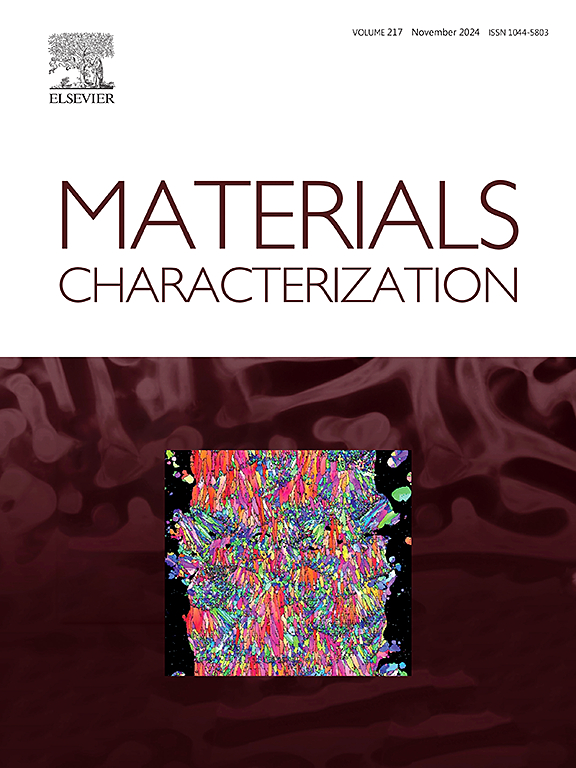wt%钼含量对WC-10Ni/Mo涂层高温摩擦学性能的影响
IF 4.8
2区 材料科学
Q1 MATERIALS SCIENCE, CHARACTERIZATION & TESTING
引用次数: 0
摘要
马氏体时效钢广泛应用于汽车和航空航天部件;但是,由于其磨损和摩擦特性差,不应暴露在高温下。本文研究了温度对马氏体时效钢中添加10% ~ 30%钼的WC-10Ni涂层的影响。用Al2O3球盘摩擦计测试了涂层在室温、300和600°C、10和30 N载荷下的磨损和摩擦性能。采用SEM、XRD、密度测试、显微硬度测试、孔隙率评估、表面粗糙度测试和结合强度评估等方法对涂层进行了表征。利用三维轮廓仪和SEM-EDS确定了磨损速率和机理。结果表明,WC-Ni/ 10% Mo涂层比WC-Ni/ 20% Mo和WC-Ni/ 30% Mo涂层具有更高的结合强度和显微硬度。基体的磨损率随温度的升高而增大。WC-Ni/ 20% Mo和WC-Ni/ 30% Mo涂层的磨损率在300℃前呈上升趋势,在600℃时呈下降趋势。在600°C时,涂层包含NiWO4、WO3、MoO3和NiMoO4等氧化物相,有助于降低磨损率和摩擦系数。此外,当温度升高时,所有三种涂层和基材的摩擦系数都下降。在所有载荷和温度下,WC-Ni/ 10% Mo涂层均优于WC-Ni/ 20% Mo、WC-Ni/ 30% Mo涂层和基体的摩擦磨损系数。特别是在高温下,疲劳磨损和磨粒磨损占主导地位,但在600℃时都出现了氧化、粘合和磨粒磨损。WC-Ni/ 10% Mo涂层比WC-Ni/ 20% Mo和WC-Ni/ 30% Mo涂层的体积损失要大,这是由于WC-Ni/ 10% Mo涂层硬度更高。本文章由计算机程序翻译,如有差异,请以英文原文为准。
Effect of wt% molybdenum content on the tribological properties of WC-10Ni/Mo coatings at elevated temperatures
Maraging Steel is widely used in automotive and aerospace components; however, it should not be exposed to high temperatures because of its poor wear and friction characteristics. This study investigates the effect of temperature on WC-10Ni coatings with the addition of molybdenum from 10 to 30 wt% applied on a Maraging Steel using a high-velocity oxy-fuel technique. A ball-on-disc tribometer with Al2O3 as a counterpart was used to evaluate the wear and friction properties of the coatings at RT, 300, and 600 °C and 10 and 30 N of load. The coating characterization was carried out using SEM, XRD, density measurements, microhardness testing, porosity evaluations, surface roughness measurements, and bond strength assessment. The wear rate and mechanism are ascertained using a 3D profilometer and SEM-EDS. The outcomes demonstrate that the WC-Ni/10 %Mo coating has greater bond strength and microhardness than the WC-Ni/20 %Mo and WC-Ni/30 %Mo coatings. The wear rate of the substrate increases with increasing temperature. The WC-Ni/20 %Mo and WC-Ni/30 %Mo coatings showed increasing wear rates until 300 °C, decreasing at 600 °C. At 600 °C, coatings included oxide phases such as NiWO4, WO3, MoO3, and NiMoO4, which helped lower the wear rate and coefficient of friction. Moreover, when temperatures rose, the coefficient of friction for all three coatings and substrates dropped. At all loads and temperatures, the WC-Ni/10 %Mo coating was well performed compared to WC-Ni/20 %Mo, WC-Ni/30 %Mo coating, and substrate regarding coefficient of friction and wear resistance. In particular, fatigue and abrasive wear predominated at RT, but oxidative, adhesive, and abrasive wear were all seen at 600 °C. The volumetric loss of the ball for WC-Ni/10 %Mo is higher than that of WC-Ni/20 %Mo and WC-Ni/30 %Mo coatings due to the higher hardness of WC-Ni/10 %Mo coating.
求助全文
通过发布文献求助,成功后即可免费获取论文全文。
去求助
来源期刊

Materials Characterization
工程技术-材料科学:表征与测试
CiteScore
7.60
自引率
8.50%
发文量
746
审稿时长
36 days
期刊介绍:
Materials Characterization features original articles and state-of-the-art reviews on theoretical and practical aspects of the structure and behaviour of materials.
The Journal focuses on all characterization techniques, including all forms of microscopy (light, electron, acoustic, etc.,) and analysis (especially microanalysis and surface analytical techniques). Developments in both this wide range of techniques and their application to the quantification of the microstructure of materials are essential facets of the Journal.
The Journal provides the Materials Scientist/Engineer with up-to-date information on many types of materials with an underlying theme of explaining the behavior of materials using novel approaches. Materials covered by the journal include:
Metals & Alloys
Ceramics
Nanomaterials
Biomedical materials
Optical materials
Composites
Natural Materials.
 求助内容:
求助内容: 应助结果提醒方式:
应助结果提醒方式:


